Securing your internet connection is crucial for protecting your personal information and maintaining online safety. Without proper security measures, your network could be vulnerable to cyberattacks, unauthorized access, and data theft. This guide will provide practical steps to help you secure your internet and safeguard your digital life.

Why Securing Your Internet Is Important
Firstly, internet security is vital because it helps protect your personal data from cybercriminals. With increasing incidents of hacking and data breaches, securing your internet connection reduces the risk of unauthorized access to your sensitive information. Moreover, a secure network ensures that your online activities remain private and prevents malicious software from infecting your devices.
Furthermore, securing your internet connection helps maintain the performance of your network. Without proper security, unauthorized users could slow down your connection by consuming your bandwidth.
Steps to Secure Your Internet Connection
1. Change Default Router Settings
Changing the default settings of your router is one of the first steps in securing your internet:
- Update Default Passwords: Log in to your router’s management console and change the default username and password. Default credentials are often easy targets for hackers.
- Customize Network Name (SSID): Modify the default SSID (network name) to something unique. Avoid using personal information that could identify you or your location.
By customizing these settings, you make it more challenging for unauthorized users to access your network.
2. Enable WPA3 Encryption
Encryption is essential for protecting your Wi-Fi network from unauthorized access:
- Access Router Settings: Log in to your router’s management console and navigate to the wireless settings section.
- Select WPA3: Choose WPA3 or WPA2 (if WPA3 is not available) for encryption. These encryption methods provide strong security for your wireless network.
Enabling WPA3 encryption ensures that your network traffic is securely encrypted, making it harder for hackers to intercept.
3. Update Router Firmware
Regularly updating your router’s firmware is crucial for maintaining security:
- Check for Updates: Log in to your router’s management console and check for available firmware updates. Manufacturers release updates to fix security vulnerabilities and improve performance.
- Apply Updates: Follow the instructions to download and install the updates. This process typically involves uploading the firmware file through the router’s settings.
Updating firmware helps protect your router from known security threats and vulnerabilities.
4. Use Strong, Unique Passwords
Strong passwords are vital for securing your network and devices:
- Create Complex Passwords: Use a mix of letters, numbers, and special characters for your Wi-Fi password and router login credentials. Avoid easily guessable passwords.
- Avoid Reusing Passwords: Ensure that your passwords are unique and not used for other accounts or services.
Strong, unique passwords make it more difficult for unauthorized users to gain access to your network.
5. Enable Network Firewall
A firewall helps block unauthorized access to your network:
- Activate Router Firewall: Log in to your router’s management console and enable the built-in firewall. This feature helps protect your network from external threats.
- Configure Firewall Settings: Adjust firewall settings to block suspicious activity and restrict unauthorized access.
Enabling and configuring your network firewall adds an additional layer of protection against cyber threats.
6. Monitor Connected Devices
Regularly monitoring connected devices can help detect unauthorized access:
- Check Device List: Access your router’s management console and review the list of connected devices. Look for any unfamiliar devices.
- Disconnect Unauthorized Devices: If you find any unauthorized devices, remove them from your network and update your Wi-Fi password.
Monitoring connected devices helps ensure that only authorized users have access to your network.
7. Secure Your Internet of Things (IoT) Devices
IoT devices can be vulnerable if not properly secured:
- Change Default Passwords: For IoT devices, change default passwords and set strong, unique ones.
- Update Firmware: Ensure that IoT devices have the latest firmware updates to address security vulnerabilities.
Securing your IoT devices prevents them from becoming entry points for cyberattacks.
8. Use VPN for Enhanced Privacy
A Virtual Private Network (VPN) adds an extra layer of privacy and security:
- Choose a Reputable VPN Provider: Select a VPN service with strong encryption and a good reputation for privacy.
- Install and Configure VPN: Install the VPN application on your devices and configure it according to the provider’s instructions.
Using a VPN encrypts your internet traffic, making it more difficult for third parties to monitor your online activities.
Conclusion: Securing Your Internet for a Safe Online Experience
In conclusion, securing your internet connection is essential for protecting your personal information and maintaining online safety. By following these practical steps—changing default router settings, enabling WPA3 encryption, updating firmware, using strong passwords, enabling a network firewall, monitoring connected devices, securing IoT devices, and using a VPN—you can significantly enhance your network security.
Additionally, staying vigilant and regularly reviewing your security measures ensures that you continue to safeguard your digital life against evolving cyber threats. A secure internet connection provides peace of mind and protects your sensitive data from unauthorized access and malicious attacks.









